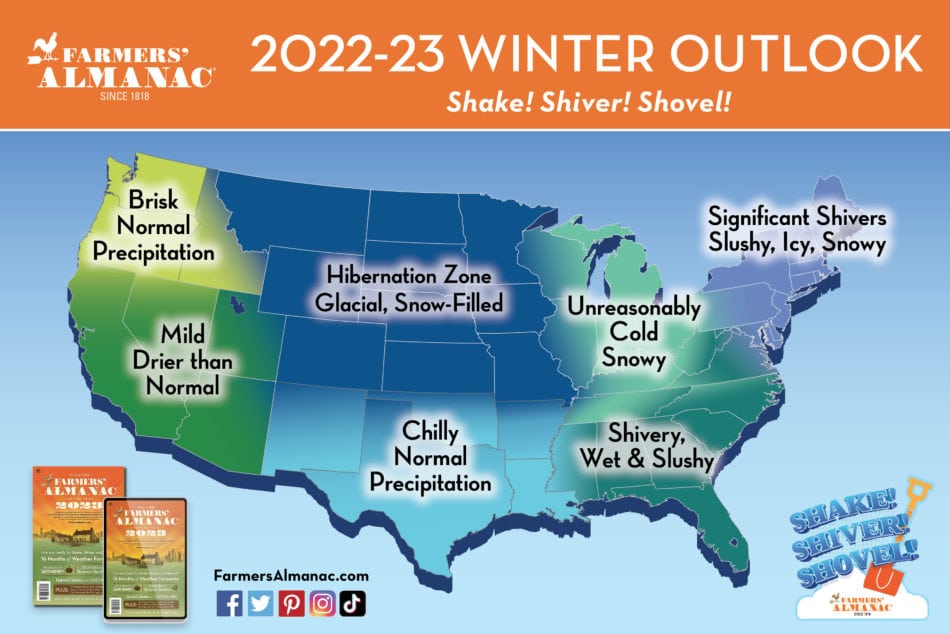
Are you ready to Shake, Shiver, and Shovel? Farmers’ Almanac Predicts Extreme Winter
Every year since 1818, the Farmers’ Almanac provides an extended weather forecast that helps people plan ahead. This year, with the extreme summer weather conditions broiling the country, and the growing concern over the rising costs of heating oil, Farmers’ Almanac is releasing its winter weather forecast earlier than ever. Farmers’ Almanac 2023, which hits store shelves on August 15, is warning readers that this winter will be filled with plenty of shaking, shivering, and shoveling.
Winter Storm Warnings
What we hear more often than not is how much snow will you get. When will the winter storm warnings start? (And when will it end!?) Well, according to our extended forecast, there should be quite a few significant winter weather disturbances nationwide in 2022-2023. A few of these dates include:
- The first week of January in the Rockies and across the Plains. During this time, we see good potential for heavy snow that may reach as far south as Texas and Oklahoma, followed by a sweep of bitterly cold air.
- January 16-23, we’ll raise another red flag for bouts of heavy rain and snow across the eastern two-thirds of the country followed by what might be one of the coldest outbreaks of arctic air we have seen in several years. How cold? Try 40 degrees below zero!
How Much Snow Will You See This Winter Season?
- Winter 2022-2023 should be dominated by an active storm track in the eastern half of the country, running from the western Gulf of Mexico to the northeast, across the Virginias, and across interior New York State and New England.
- Areas south of the storm track (much of the Southeast) will see frequent storms bringing cold rains and a wintry mix of wet snow, sleet, ice, freezing rain—as well as chilly temperatures.
- The I-95 corridor can be included in this winter mix zone with places to the north of the track seeing the precipitation fall more as snow and at times, a lot of it. This may be especially true over the Ohio Valley and Great Lakes area.
- Snow lovers will be happy in the North Central States as they will see a fair share of storminess during the winter season, which should mean plenty of snow for winter enthusiasts to enjoy (maybe even in time for a white Christmas?).
- The South Central States are forecast to see some accumulating snow, especially in early January. The Far West and the Pacific Northwest will see about-normal winter precipitation; however, the Southwest will experience less than normal.
How Cold?
The big takeaway for our winter season forecast is that frigid temperatures should flow into many areas nationwide—especially in the North Central region, where readers will certainly be shaking and shivering!
- A cold December and a very cold January might make readers in the Northeast shake and shiver. But February will bring milder temperatures that should make winter seem more bearable.
- The Southeast will experience some shivers, especially during the month of January. Fortunately, for the snowbirds, February will likewise warm the region to near-normal winter season temperatures overall.
- Winter will feel unreasonably cold for readers in the Great Lakes region, especially in January.
- Farther south, into the Southern Plains, temperatures will average chillier than normal.
- The Pacific Northwest will see brisk/cool conditions, and the Southwest will be the mild area of the country, with near-normal winter temperatures.
- Shivery temperatures are predicted to rattle warm weather seekers in the Southeast and South Central states, but the real shivers might send people in the Great Lakes areas (Northeast and North Central regions) hibernating. According to the Almanac, the North Central States are forecast to experience extremely cold temperatures during mid-January—possibly 40 degrees below zero!
- Areas in the western half of the country should escape major shivers, with an overall forecast of brisk temperatures predicted in the Northwest and mild temperatures in the Southwest.
Shovel Worthy
The Farmers’ Almanac suggests a stormy winter is on schedule, especially for the eastern half of the country. For some areas, this may mean snow, but for others, it will result in more slush and mush.
January 2023 looks to be the stormiest for many areas including Texas and Oklahoma, where heavy snow is predicted during the first week. Unfortunately, a dry winter is predicted for the Southwest states, which won’t help the drought situation.
When Will It Warm Up?
After the vernal equinox, when we should be slipping into spring, expect a lion-like end of March. There should be a wide variety of weather conditions, ranging from heavy snows to torrents of rain to gusty thunderstorms across much of the nation.
Last year, the Almanac predicted many of the 2021-2022 winter storms, most notably: the early-season nor’easter at the end of October, and the unusual blizzard in the last week of April (in parts of Montana, Wyoming, and the Dakotas).
The new edition features many new elements, including weather maps for all four seasons and redesigned calendar pages for easier reference.
“with the extreme summer weather conditions broiling the country”
??? It’s been 6-8 degrees below normal here for the last 6 weeks. My fruit trees think it’s fall. No where is above average temperature right now.